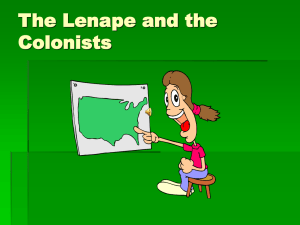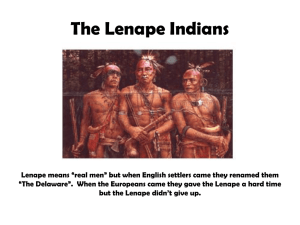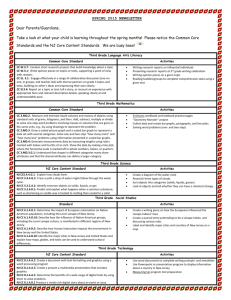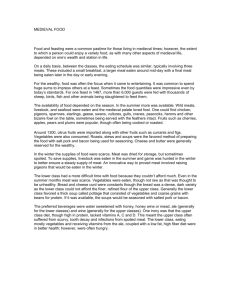hunting - Hudson River Sloop Clearwater
advertisement
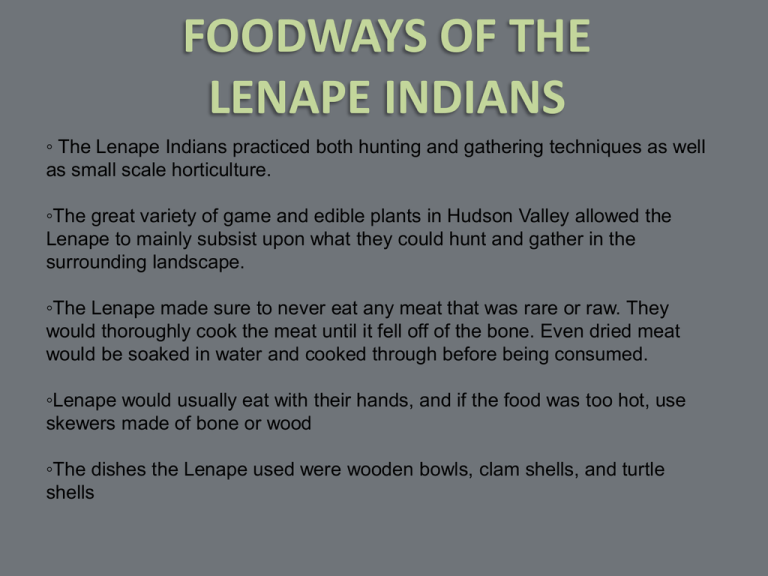
FOODWAYS OF THE LENAPE INDIANS ◦ The Lenape Indians practiced both hunting and gathering techniques as well as small scale horticulture. ◦The great variety of game and edible plants in Hudson Valley allowed the Lenape to mainly subsist upon what they could hunt and gather in the surrounding landscape. ◦The Lenape made sure to never eat any meat that was rare or raw. They would thoroughly cook the meat until it fell off of the bone. Even dried meat would be soaked in water and cooked through before being consumed. ◦Lenape would usually eat with their hands, and if the food was too hot, use skewers made of bone or wood ◦The dishes the Lenape used were wooden bowls, clam shells, and turtle shells HUNTING ◦ Lenape men and older boys were assigned the job of hunting ◦ The most commonly hunted animals in Lenapehoking were deer, elk, black bear and raccoons ◦The prime time for hunting was in Autumn, when the animals were fattened by eating the abundant nuts ◦In Autumn, any able bodied men, women and older children would depart for winter hunting camps. After a few months of hunting, they would return to the permanent settlement laden with venison, skins, firewood, bone grease and nuts ◦ Hunting territories of the Lenape Indians could be as large 200 square miles, but most were much smaller. ◦These territories were bounded by natural markers, such as streams and hillsides. ◦Traditional rights to hunting areas were honored ◦Most hunting areas were the interior mountain regions, because they were so sparsely populated ◦Indians would generally not kill more than they could eat, process or use for skins HUNTING TOOLS USED ◦ By the late woodland period, spears and lances had been replaced by bows and arrows ◦ Stone projectile points were made of chert and other fine grained lithics ◦ These stone projectile points were more common than those made of antler and bone ◦ Levanna and Madison projectile points were the most commonly constructed points ◦ Madison points are more of an isosceles shape and the bases are generally straight or slightly convex. They appear less frequently than the Levanne projectile point. The Levanna point is more equilateral with bases which are usually concave ◦ Arrow shafts were made of fine grained wood or cane ◦ A carefully selected stick would be soaked in water, heated over a fire and re-shaped until it was in the desired shape. The stick was then shaved to a uniform diameter, and lastly run through a “shaft smoother”, which was a piece of sedimentary rock which would sand the arrow shaft. PROJECTILE POINTS Madison Projectile Points Levanna Projectile Point Arrow Shaft Smoothers ANIMALS DEER ◦ The white-tailed deer was a very important source of raw material for the Lenape Indians ◦The Meat could be eaten, either shortly after being killed by cooking over a fire or boiling; or dried and stored for later use ◦The skin could be tanned and made into a variety of useful items, such as clothing, sleeping robes, mats, wall hangings or bags ◦The antlers and bones could be made into a variety of tools, such as needles, hooks, skewers and projectile points, as well as ornamental objects ◦The tendons and intestines could be made into sinew and used as a thread or as a binder ◦Hooves could be made into rattles, and even sometimes into glue ◦Deer were hunted all year round, but mainly in autumn and early winter ◦Hunters would use a variety of methods to getting deer. ◦Stalking was the most common method. A hunter would follow a deer, sometimes for miles, taking advantage of the fact that deer would always run in arcs. Hunters would follow the same animal, heading it off, and forcing it to run for hours until it was tired and the hunter could get with in closer range ◦ Burning of forests and thickets was done to make tracking and stalking easier, but it also created fields with tall grasses that elk and deer needed to thrive. Hunters would sometimes burn a large ring, forcing the animals further into the center, which enabled the hunters to acquire a large amount of game in a fast and efficient manner. ◦The Lenape would also use communal drives if there were enough people and animals. A group of men would herd the deer in the direction of a v-shaped enclosure, called a fyke ANIMALS BLACK BEAR ◦ Black bears were another very important resource to the Lenape Indians ◦ Meat was good to eat ◦ Fat was rendered and used as a pomade for hair, as well as an ointment for the skin [useful in preventing sunburn and keeping mosquitoes away] ◦ Oil was used to dip venison in ◦ Pelt with fur left on was an especially good sleeping robe and it could also be used to make winter moccasins ◦ The canines and claws were also occasionally used for necklaces and ornaments ◦The black bear was treated with more respect than any other game animal, and was referred to as “grandfather” ◦ The black bear got this nickname because it looked somewhat human-like while standing on its hind legs, and even more so when skinned ◦ Special care was taken to not offend the spirit of the bear, and help it return to the spirit world. ◦ Some tribes would dispose of the bones carefully, so as to make sure that dogs would not gnaw on them ◦The black bear pelt was also a costume worn by Mesingw in the important “Big House” ceremony ANIMALS ◦ Other animals hunted by the Lenape were: ◦ Raccoon, the meat was similar to the black bear’s ◦ Elk, which provided good skins and meat ◦ Beavers were eaten, and tails were considered a delicacy and the best tasting meat available ◦ Porcupines were also considered a delicacy, and its quills were dyed and used as decoration for clothing and as ornaments for a septum piercing ◦ Skunk and pole-cat were eaten, as there was no offensive odor to the meat ◦ Squirrels were eaten in times of sickness, or when there was no other meat available ◦ Panther, lynx, wolf, bobcat, fox and other carnivores’ pelts were used, but the meat was never eaten as it was too strong. ◦ Birds provided meat, eggs and feather for decoration. ◦ Turtles provided meat, eggs and their shells which could be used as rattles or as utensils ANIMALS GATHERING ◦ Another way the Indians in Lenapehoking supplemented their diet was through extensive gathering ◦ The job of gathering was delineated to women and children ◦ Gathering was important because the caloric intake of gathered foods far surpassed the calories spent collecting them ◦ The Lenape utilized about 370 native plants ◦ These plants were used not only for foods and beverages, but also for medicinal, ceremonial, smoking, dyeing and utilitarian purposes ◦ Through hundreds of years of trial and error, the Indians learned which plants and which parts of those plants were useful and edible ◦ Depending upon the season, women and children would contribute between 60-80 percent of the diet ◦ One of the most important items collected for consumption were the nuts from local trees GATHERING NUTS ◦ Nuts were an important part of Lenape diet, as they were abundant and a good source of both protein and fat ◦ Chestnuts are composed of 11% protein and 7% fat, with the rest of it being starch ◦ Acorns from the White and Bur oak trees were low enough in tannic acid that they didn’t require as much prep as other types of acorns. These nuts are low in protein, but very high in fats and carbohydrates ◦ Other nuts eaten were black walnut, beechnut, butternut and hickory ◦ Nuts were processed to be eaten right away and were also stored for later consumption ◦ The nuts were oftentimes roasted in hot ashes, crushed in wooden mortars, and the mash was then put in basket strainers and leached in running water to separate the meat from the shell ◦ The mashed nut meat would be dried and stored for winter. ◦ Beechnuts had to be processed a little differently because of their hard shells. ◦ The beechnut would first be pounded in a mortar, next both shell and meat would be placed in water to boil. After a bit, the oil would float to the top. This nut oil would then be skimmed off and saved for later use. ◦ “Nut milk” was another important product obtained from nuts ◦ This was prepared by taking boiled and mashed nuts and passing them through very fine strainers. The “milk” would come out, which was full of proteins and fats White Oak Acorn Chestnuts GATHERING ◦ Other foods gathered by Lenape women and children were: ◦ Different types of spring and summer berries, such as strawberries, elderberries, huckleberries, blueberries, blackberries, raspberries, black thimble-berries, cedar berries ◦ Different types of leaves and sticks, which were used to make teas ◦ Tubers, such as cattail ◦ Different fruits, like persimmons and apples ◦ Mushrooms ◦ Bird and turtle eggs ◦ Shellfish and crustaceans ◦ Frogs and turtles FISHING ◦The rivers, streams and wetlands of the Hudson Valley provided a plentiful amount of resources to the Lenape Indians ◦ From the fresh water streams the Lenape were able collect drinking water ◦Many different types of fish were caught in using a variety of tools and skills ◦ Crustaceans and shell fish could be gathered from both fresh and salt water Different stages of bone fishhook construction Stone net sinkers FISHING ◦ Because it connects to the ocean, the Hudson River has an amazing variety of both fresh and salt water species ◦The Lenape Indians knew this, and supplemented their diet with whatever they could get from the river ◦Men, women and children would all participate in gathering shellfish and crustaceans along the shores ◦Men and older boys would use nets, weirs, hooks, spears, double pointed fish gorges and harpoons to obtain fish ◦Often times, men would go out on a stream in canoes and stretch nets across the entire length of it ◦Other times, Lenape men would use the nets to herd fish towards the weirs ◦Weirs were also constructed above the low tide level, so when the tide went out, fish would be trapped and left behind, easily picked up by women and children ◦Many fishing implements did not survive in the archaeological record, nor do the easily decomposed fish bones. ◦One item used in fishing, a netsinker, is one of the most commonly found stone tools at archaeological sites which are located near water ways. ◦This is probably because they are easily made and so a disposable item FISHING ◦Many different species of fish were caught and eaten. The most common of these fish were: ◦ Sturgeon, which could reach up to 16 feet long, and well over 200 pounds. The large back plates, called scutes, are sometimes found in archaeological sites which date to before Henry Hudson entered the river. ◦ Shad were extremely plentiful when they came into the Hudson River in early spring to spawn. It was recorded that in the 19th century, fisherman would catch between 14 and 20 million pounds of shad a year. ◦ Striped bass were another large fish which would return to the river to spawn ◦ Eel would be fished on their return trip to the ocean, and caught by the hundreds in a special type of net known as an “eel pot” ◦Occasionally whales, porpoises and harbor seals supplemented the diet, usually these were beached animals COMMON FISH Striped Bass American Shad American Eel American Sturgeon FISHING ◦Other animals the Lenape Indians gathered from waterways for consumption, were: ◦Conches: the meat could be eaten and the inner whorl of the shell could be cut and sanded to a bead of desired size. These beads could be used in decoration or for wampum ◦Clams: the meat was good to eat, and Quahog Clam shells could be used as utensils, tools, and wampum ◦Oysters: the shells of oysters are a very common find at Lenape sites along the Hudson River ◦ Mussels ◦ Crabs ◦ Crayfish ◦ Lobsters FARMING ◦ Despite the fact that there were many different types of food available to hunt and forage for, the Lenape Indians practiced small scale horticulture ◦ The Lenape planted and tended to three main crops which were maize, squash and beans. This trinity of plants is known as “The Three Sisters” ◦ The corn stalks provided support for the beans to grow, the squash kept moisture in the soil with its broad leaves, while simultaneously keeping down weeds, and the beans helped to return nitrogen to the soil that was taken out by the corn ◦ Beans contain amino acids and tryptophan, which the body needs to produce protein and niacin. Combined with maize, this creates a relatively balanced diet. FOOD PROCESSING ◦ Most vegetables were eaten as they ripened, but some were also dried and stored for later consumption MAIZE ◦ This vegetable could be eaten in a variety of ways. ◦ If fresh, it could be eaten raw, be boiled, roasted, or made into succotash, which combines it with beans, veggies and meat/fish ◦ Maize could by dried by first boiling it, then it would be dried out, the kernels would be removed from the cob and stored in bark or skin containers ◦ Once dried, it could be made into ◦ Hominy, which is made by boiling the kernels with wood ash ◦ Flour, which is made by finely grinding the dried kernels with a stone mortar and pestle. The flour could be made into various foods, such as unleavened bread and sapan [cornmeal gruel, which was a Lenape staple food] FOOD PROCESSING BEANS ◦ Beans could be eaten fresh ◦ They could also be dried ◦This was done by first boiling the beans for a few minutes, then drying them out and storing them in bark or skin containers SQUASH/PUMPKINS ◦Like corn and beans, squash and pumpkins were often times eaten fresh, but could also be dried and put away for the winter months ◦These vegetables were dried by cutting them into thin rings, stringing the rings onto a strip of leather and hanging it in the sun to dry. These dried rings could be stored by hanging them from rafters, or by being put in storage containers
